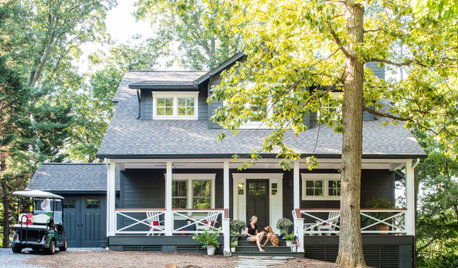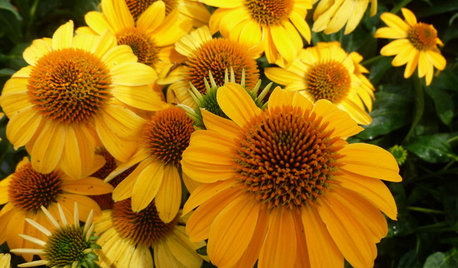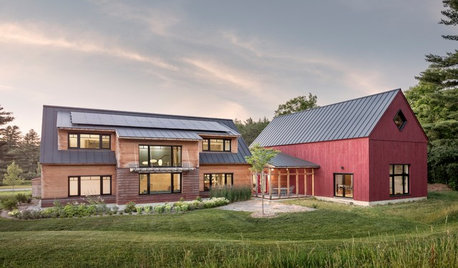October 2018, Week 1
Okiedawn OK Zone 7
5 years ago
last modified: 5 years ago
Featured Answer
Sort by:Oldest
Comments (35)
slowpoke_gardener
5 years agofarmgardener
5 years agoRelated Discussions
August 2018, Week 1, Fire and Rain
Comments (68)Larry, Someone else got 5-lobed bells this year too, maybe it was someone on one of our OK gardening Facebook pages. I'll get an occasional five-lobed bell but not often. It sounds like you were very busy, even as a child. I think you would have made a great doctor because you would have been trying to save your patients, not trying to kill them by supper time (I hope). My best friend contracted polio from the vaccine when we were young children. He survived it and appeared to have mostly recovered, but had a limp forever after. The polio came back when he was in his 40s or early 50s and it killed him. I never knew that could happen---like he wasn't really cured. It stayed hidden in his body for decades and then came back strong. Nancy, I'm already exhausted and we have almost 24 hours more to go. She is more exhausted though. We were running around all day and when we got home about 2 pm, she grabbed her pajamas and told me she was going to go take her bath and get ready for bed---and she was serious. I told her it was not bed time, but swimming pool time, and she woke right up. Now she's fighting to stay awake until after dinner time. Unless she gets a second wind, I think it will be a really early night for her tonight. This week the kids are fascinated with icebox melons. I harvested 13 of them yesterday, ranging in size from about the size of an orange to the size of a cantaloupe and they are in love with the little ones, which I think are the variety Mini Love, and also in love with the fact that there are three colors of flesh---red, yellow and orange. We have tons of icebox melons to eat, and even are sharing them with the fawns and the mothers every evening. We slice and eat melons daily. The nice thing about the icebox sized ones is that they have a pretty long shelf life, so you can cut one or two every day and there's less (if any) left over to put away in the fridge. I don't even put all the melons in the icebox----I just leave them sitting on a counter until we use them. Usually if we cut one or two, we eat all of them that day, or throw out the leftover pieces for the deer. It is so much more convenient than having to cut up a huge one and deal with pieces of it in the fridge for days and days. I didn't do anything in the garden today. I'm just hoping and praying the heavy rain they're saying we will get on Sunday and Monday actually happens. There's been a ton of rain to our south in Texas, particularly in the areas that are in Extreme Drought, so I know that those folks are relieved. The amount of rain they got won't remove the drought, but might knock it back a good deal. The cooler temperatures are very, very nice, so at least we have that, whether the rain comes or not. The garden still looks pretty bad, but when I consider that we're in Severe Drought, I realize it looks about as good as it possibly can considering the weather we are having. Dawn...See MoreSeptember 2018, Week 1, September Morn.....
Comments (33)Lisa--so amazed you did it, and so proud of you for doing it! And am so thrilled it was good for you. I've had two other friends who did it, as well. Very rewarding for both, just to know. One of the friends and her family bonded and see each other. Wasn't as good an experience for the other, but she was grateful that she knew about it all, finally. The deer incident affected me more than I thought it would. First, the reality of it and how to handle it. How sad it was to see this creature in such distress. And how problematic it seemed to wonder about the appropriate way to deal with it. It's like we live in the country, with all the critters around us; and yet we live in the country with neighbors very near to us, save for the forest directly across the front of our immediate property and behind our immediate property. GDW felt strange, walking across the street and shooting the poor thing in view of whoever might be driving by or outside. I felt a little freaked when I went out to help him load her into the truck, and two vehicles drove by about that time. I don't think they saw the deer, who was in a bit of a ditch right next to the road, but I felt kind of like a criminal. Had push come to shove, we'd have felt fine about our actions had we been asked to explain. I suggested we call the game wardens, but GDW said the chances of them being able to come right out were slim; so that's when we loaded her into the truck to go to the burn pile. As it stands now, she is still in back of the truck; we will unload her tomorrow nearby, with the nice game warden's blessing. He said I might be surprised to know how many calls they get like ours. And he told me to thank my husband for him, in choosing to put her out of her suffering. And here was poor Garry, with one eye swollen shut! He waves it off, and any of the rest of us might, too. But he is definity hampered temporarily. Now if he was going to be like that from now on, he'd get used to it. We've been laughing about it today; I found myself thinking, "Let's see; if I lose an eye, which one would I prefer to lose. Definitely my left one." hahaha I've been loving binge-watching Anthony Bourdain's Parts Unknown series, connecting with people all around the world through food. I had only caught 2-3 of the shows when I had TV. Liked them, but not the way I do now. Eileen, it's your fault. How little I knew about Singapore! And now I know a LOT about that supercity/super country. (AND my new favorite, Asian foods and learning to fix them!) And it sort of lit me on fire with how little I know of other cultures. I won't be doing any traveling (not any more than necessary now), but I will travel through books and excellent documentaries. I am absolutely blown away by these journeys of Bourdain's, and the care and attention that team took, to present important and worthy shows that illustrate societies around the world and our commonality. And the sadness many of the countries have gone through, might even be going through now, and the buoyancy and resiliency of the people. And how he manages to bond/communicate with them in these episodes, and also to introduce the rest of us to these people all around the world, a bit of their history, and the common love of food. Great show, glad I finally am watching it all. And so with this great Asian way of cooking, it has ignited and changed to some extent, the way I want to grow veggies. I see a lot more greens in the future. Sigh. I hate salad. BUT when I watch or read about Asian cooking, greens look good and fun! LOL Thanks, Eileen. It's a little late to be planting some of what I want to, but have gone out on a limb with a few. But will be putting in a few more greens tomorrow. I got my garlic order in to SESE before they ran out; I got my coral honeysuckle order into Almost Eden (I had it in the cart and just remembered yesterday that I hadn't punched "Order.") So did that. And you guys know how it goes. Couldn't order JUST one thing, so also ordered some rainbow-kinda colored echinacea--a couple of them. That was because my present grown-from-seed ones have done so splendidly. I was so so ticked off today pulling Bermuda out of the front shop bed and the back Bermuda bed. I hate Bermuda. I'd rather have mud or dirt in our "lawn," or crabgrass, than Bermuda. YES, it's fairly easy to get out with my Hori Hori, but it's every brutal inch or two, and in the front bed today, some of it was 10 inches down. Thing is with those two beds, I didn't properly prep them in the first place and work to get it all out. Hmm. On the other hand, the soil is so much better now and deep enough, and loose enough, that it's easier to get out. So. I guess it's okay. My concern is the established plants. I may end up having to take them all out, just to get all the Bermuda. I hate Bermuda. Will sign off. Life is fragile, we must remember to appreciate every single day, even Bermuda grass days. Maybe especially Bermuda grass days. We're dealing with it, we're fixing it, inch by slow inch! And so far, I'm digging it up faster than it can grow . Diligence will produce victory....See MoreOctober 1, 2018 Condo Kitchen Demo Date!
Comments (19)It was a quiet week on the kitchen front, but quiet progress was made. Plumbing rough inspection was done, electrical walk through planning was done and drywall was measured for. Electrical starts tomorrow. I’m unsure about the lighting plan, but the electrician, designer and GC all seem to be in agreement and happy, so I’ll trust that they have seen the finished result many times and I have not....See MoreOctober 2018, Week 3, From Summer to Autumn to Winter
Comments (38)Jennifer, I'm hoping you were able to finally make it home, enjoy Wine Wednesday, and get some rest. You cannot go into this weekend too tired! Some other weekend, yes, but not this one because you are going to stay so busy. Rebecca, Hmmm, pepper bitterness generally only is a problem is you are harvesting them and using them green. They only truly shed the bitterness when allowed to ripen to their full mature color, but there are different degrees of bitterness along the time scale so that the further peppers progress away from being younger and smaller to being older and larger, though still green, the more the bitterness usually fades. I don't know of any weather or nutrient condition that makes them more bitter, but if I run across any description of something that does, I'll try to remember to come back here and tell you. When our mom told us to go out and play, it was pretty easy for me to go out, play a very short while, and then quietly slip back into the house and go into my bedroom and read. With 4 kids coming and going, if you were quiet once you were indoors, you could get away with that. With the seeds that you're sowing that won't sprout, are you surface sowing? That is what works best with me with green seeds---I broadcast sow on the surface of the growing medium and don't cover them up. I do lightly pat them down so they have good soil contact. I don't know if the seeds of greens necessarily need light to sprout, but I know they sprout better (and at a higher germination rate) for me if I don't cover them with soil. I got lower germination rates and slower germination when I covered them, even lightly, with anything---even compost or the lightest amount of peat moss. You are NOT a garden failure. It is either the seeds or the growing conditions that are failing you, so be kind to yourself and please stop feeling like a failure. If I were to allow myself to feel like a failure every time something in the garden doesn't go my way, I'd be so depressed and disheartened that I'd give up gardening. Instead, I push on relentlessly, overplanting everything, figuring if one thing doesn't work, another one will. And, on a lighter side, this is Oklahoma where the weather is cray-cray, so just blame the weather when something fails! Jennifer, You're welcome, and I agree that gardening is grounding. I feel like it surely is as good for our bodies as it is for our souls. I understand how you feel about meat, and I think you are not imagining it---you just have a soul that likely communicates with the souls of the animals. I feel that same way about people, especially native people here in the USA. When we visit a state park, for example, which is the scene of large battles between the native Americans and the European invaders who called themselves Americans, I swear I can feel the souls of the native Americans talking to me....like, I am walking in their shoes on their land, though not in a literal sense as I am not at war with anyone. I feel their pain and suffering when I walk an area like that--not in an intellectual way, but in a true emotional/intuitive way. The first few times it happened to me, I felt quite unsettled by it and then I decided to just accept it and to not try to overanalyze it or to fight it. I hope y'all enjoyed sleeping in today. Nancy, I really used to live in pepper hell because I'd grow 15 or 20 kinds of peppers and wear myself out trying to preserve them all. Now I grow only a few kinds, and only the ones we adore most, and it has made the pepper section of the garden easier to control, and has made the inevitable kitchen mess/workload more manageable too. When we first moved here and I finally had a sunny space to grow stuff (in the city, we had far too much shade so my garden was tiny), I grew far too much of everything. It was fun, but the garden and my life both are more manageable now that I have cut back and am trying to grow only enough excess beyond what we eat fresh to give us some food to preserve instead of trying to grow as much as possible and then ending up worn out from dealing with all the excess. It did take me about 15 years of growing far too much of everything before I started cutting back, and I still am trying to get the balance right so we have enough of each thing, but not too much of anything. Well, with tomatoes, I'll likely always grow too many just because I like to have a wide variety of shapes, sizes, colors and flavors. If growing too many tomatoes is my worst garden vice, then I think I'll be okay. Tiny will learn. Even Yellow Cat, who roamed our neighborhood for a good 10-12 years as a semi-feral cat before deciding to move in with us for his retirement years, still had to learn. After a lifetime of dodging wild things, he still liked to come inside and sleep all day and roam all night, which made me nervous. After a bobcat chased him up onto the roof of our house during the middle of the night, and I awakened to horrible screaming and had to quickly open a second story window to bring him in off the porch roof, he quite abruptly became an indoor cat at night, and outdoor by the day. By then he must have been 14 or 15 years old at least. He might have learned the lesson of nighttime safety a bit later than I would have liked, but he learned it, and then he lived for several more years to enjoy his retirement before he died of old age. My dad was naturally quiet by nature, and I took after him, so I never really was a chatterbox. Our oldest granddaughter? She'll talk 24/7 if you'll let her, and I never knew constant chatter could wear me out until now. We are trying to teach her that it is okay to ride in the car, for example, in companionable silence if you don't really have anything to say that isn't just mindless chatter. It is getting better, bit by bit, but we have a ways to go yet. We got drizzly, drippy, mostly misty rain most of the day yesterday, so no sunshine yet again and today is expected to be pretty much the same. The heavier rain is expected tomorrow. I miss the sunshine. The amount of mud we have is unreal. In the back where I feed the deer, the mud is just a churned up mess, so I keep moving the feeding area to grassier spots without as much bare ground showing, though the deer don't like change. The dogs and cats both are going stir-crazy from being indoors so much, and I am right there with them. Whenever I let them go out, or when I go out myself, because we are in between bands of rain/drizzle/mist and it seems wise to run outdoors while we can, it almost immediately starts to rain again. Just let me walk down to the mailbox without a raincoat or umbrella, and it will start to rain as soon as I am down there, 300' from the house. It happens every time. I'm so bored with being stuck indoors I have cleaned out the spice drawer and thrown away out-of-date spices, which meant (of course) making a list of the few that I threw out so I'd be sure to replace them this weekend. My constant cleaning out of drawers and things might be making Tim nervous. He survived the closet cleanout, but I haven't really touched his dresser drawers, nightstand drawers or anything in his office (where all the desk and printer table drawers are crammed full of stuff) and I think he might be worrying that someday when he is at work and I am bored, I might clean out the desk drawers and throw away some of his precious junk. Of course, I will not but the thought of it probably has him antsy. I am dying to get my hands on the garage/shop which is 1200 s.f. of 'stuff', some of which he actually needs and uses but much of which seems to be 'just in case we ever need it again' type clutter. I might make the garage/shop my 2019 project and work at it month by month. He'll have to be home when I do it though, so he won't worry I am throwing away too many of the things that he deems important. On the other hand, we'll never move to another place again because just the thought of packing up that garage/shop building would make him decide that moving is not going to be worth it. (grin) Seriously, when we moved here, we knew this was our forever home. However, I didn't know that "forever" applied to every piece of anything ever put in the garage. I'm really starting to get worried about the prospect of an El Nino winter. If the rain continues on through February the way it has been now, planting is going to be delayed for weeks if not months. I cannot decide whether to order my Dixondale onions for the usual early arrival date in February or to strategically order them to arrive 2 or 3 or maybe even 4 weeks later than usual in case the garden still is a mucky mud hole like it is right now. They've raised our chances of El Nino developing for winter here in the USA from 65-70% to 70-75%, so it is seeming more likely, even if it is going to be a Modiki El Nino instead of a regular one. Dawn...See MoreOkiedawn OK Zone 7
5 years agoluvncannin
5 years agojlhart76
5 years agoslowpoke_gardener
5 years agoluvncannin
5 years agoOklaMoni
5 years agoluvncannin
5 years agoOkiedawn OK Zone 7
5 years agolast modified: 5 years agohazelinok
5 years agoOkiedawn OK Zone 7
5 years agolast modified: 5 years agoRebecca (7a)
5 years agoslowpoke_gardener
5 years agoOklaMoni
5 years agoOkiedawn OK Zone 7
5 years agoAmyinOwasso/zone 6b
5 years agoslowpoke_gardener
5 years agoslowpoke_gardener
5 years agohazelinok
5 years agolast modified: 5 years agohazelinok
5 years agohazelinok
5 years agoOkiedawn OK Zone 7
5 years agohazelinok
5 years agolast modified: 5 years agojlhart76
5 years agoOkiedawn OK Zone 7
5 years agoOklaMoni
5 years agoNancy RW (zone 7)
5 years agoslowpoke_gardener
5 years agoAmyinOwasso/zone 6b
5 years agoOkiedawn OK Zone 7
5 years agoNancy RW (zone 7)
5 years agoluvncannin
5 years agoOkiedawn OK Zone 7
5 years ago
Related Stories

TRENDING NOWThe 10 Most Popular Kitchens of the Week From 2018
Features like cozy eat-in spaces, baking stations and a pizza oven inspired many kitchen renovation plans
Full Story
EVENTS5 Big Trends From This Week’s High Point Market
Learn the colors, textures and shapes that are creating a buzz in interior design at the market right now
Full Story
INSIDE HOUZZTop Styles, Colors and Finishes for Master Bath Remodels in 2018
Contemporary is again the No. 1 style, but farmhouse is gaining steam, according to the U.S. Houzz Bathroom Trends Study
Full Story
EVENTS6 Hot Decor Trends at Las Vegas Winter Market 2018
Designers see curvy sofas, pastels, polished woods and more black and gold coming our way
Full Story
DECORATING GUIDESInterior Design Trends Expected to Take Hold in 2018
Get the lowdown on the colors, materials and other design decisions gaining steam now
Full Story
EVENTS2018 Design Calendar: Where to Go and What to See This Year
Check out some of this year’s best design shows, tours and exhibitions around the globe
Full Story
DATA WATCHHome Remodeling Firms Mixed on Market Outlook in Q1 2021
Firms report a positive outlook overall, with construction firm expectations tempered, the Q1 Houzz Barometer shows
Full Story
FLOWERS10 New Flowering Plants for More Garden Color in 2018
These perennials and shrubs have long-lasting color and beautiful blooms, and they attract birds and butterflies too
Full Story
INDUSTRY RESEARCHRemodeling and Design Firms Optimistic for 1st-Quarter 2020
The Q1 Houzz Renovation Barometer reveals positive sentiment overall, despite economic and industry concerns
Full Story
INSIDE HOUZZHome Renovation Pros Paint a Bright Picture for the Rest of 2018
The Houzz Renovation Barometer for fourth quarter 2018 shows that wait times to work with a building firm have dropped
Full StorySponsored
More Discussions







Nancy RW (zone 7)